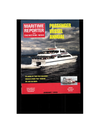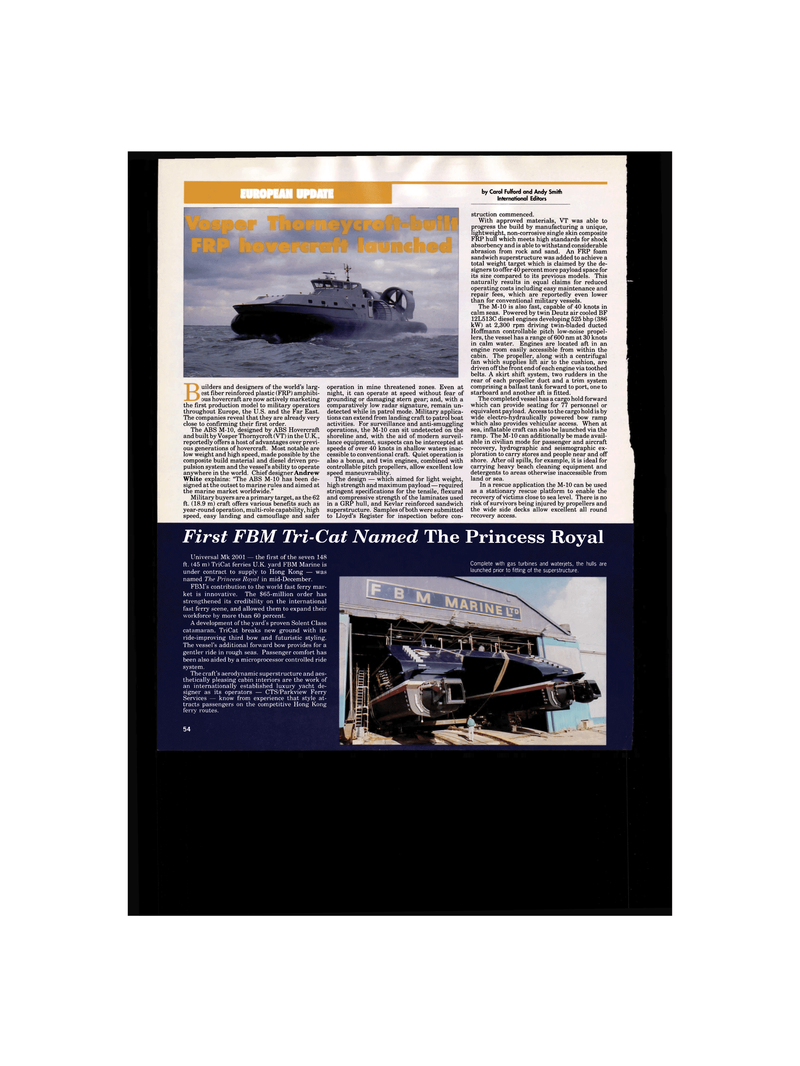
Page 60: of Maritime Reporter Magazine (January 1995)
Read this page in Pdf, Flash or Html5 edition of January 1995 Maritime Reporter Magazine
EUROPEAN UPDATE by Carol Fulford and Andy Smith International Editors
Builders and designers of the world's larg-est fiber reinforced plastic (FRP) amphibi-ous hovercraft are now actively marketing the first production model to military operators throughout Europe, the U.S. and the Far East.
The companies reveal that they are already very close to confirming their first order.
The ABS M-10, designed by ABS Hovercraft and built by Vosper Thornycroft (VT) in the U.K., reportedly offers a host of advantages over previ- ous generations of hovercraft. Most notable are low weight and high speed, made possible by the composite build material and diesel driven pro- pulsion system and the vessel's ability to operate anywhere in the world. Chief designer Andrew
White explains: "The ABS M-10 has been de- signed at the outset to marine rules and aimed at the marine market worldwide."
Military buyers are a primary target, as the 62 ft. (18.9 m) craft offers various benefits such as year-round operation, multi-role capability, high speed, easy landing and camouflage and safer operation in mine threatened zones. Even at night, it can operate at speed without fear of grounding or damaging stern gear; and, with a comparatively low radar signature, remain un- detected while in patrol mode. Military applica- tions can extend from landing craft to patrol boat activities. For surveillance and anti-smuggling operations, the M-10 can sit undetected on the shoreline and, with the aid of modern surveil- lance equipment, suspects can be intercepted at speeds of over 40 knots in shallow waters inac- cessible to conventional craft. Quiet operation is also a bonus, and twin engines, combined with controllable pitch propellers, allow excellent low speed maneuvrability.
The design — which aimed for light weight, high strength and maximum payload — required stringent specifications for the tensile, flexural and compressive strength of the laminates used in a GRP hull, and Kevlar reinforced sandwich superstructure. Samples of both were submitted to Lloyd's Register for inspection before con- struction commenced.
With approved materials, VT was able to progress the build by manufacturing a unique, lightweight, non-corrosive single skin composite
FRP hull which meets high standards for shock absorbency and is able to withstand considerable abrasion from rock and sand. An FRP foam sandwich superstructure was added to achieve a total weight target which is claimed by the de- signers to offer 40 percent more payload space for its size compared to its previous models. This naturally results in equal claims for reduced operating costs including easy maintenance and repair fees, which are reportedly even lower than for conventional military vessels.
The M-10 is also fast, capable of 40 knots in calm seas. Powered by twin Deutz air cooled BF 12L513C diesel engines developing 525 bhp (386 kW) at 2,300 rpm driving twin-bladed ducted
Hoffmann controllable pitch low-noise propel- lers, the vessel has a range of 600 nm at 30 knots in calm water. Engines are located aft in an engine room easily accessible from within the cabin. The propeller, along with a centrifugal fan which supplies lift air to the cushion, are driven off the front end of each engine via toothed belts. A skirt shift system, two rudders in the rear of each propeller duct and a trim system comprising a ballast tank forward to port, one to starboard and another aft is fitted.
The completed vessel has a cargo hold forward which can provide seating for 77 personnel or equivalent payload. Access to the cargo hold is by wide electro-hydraulically powered bow ramp which also provides vehicular access. When at sea, inflatable craft can also be launched via the ramp. The M-10 can additionally be made avail- able in civilian mode for passenger and aircraft recovery, hydrographic and seismographic ex- ploration to carry stores and people near and off shore. After oil spills, for example, it is ideal for carrying heavy beach cleaning equipment and detergents to areas otherwise inaccessible from land or sea.
In a rescue application the M-10 can be used as a stationary rescue platform to enable the recovery of victims close to sea level. There is no risk of survivors being injured by propellers and the wide side decks allow excellent all round recovery access.
First FBM Tri-Cat Named The Princess Royal
Universal Mk 2001 — the first of the seven 148 ft. (45 m) TriCat ferries U.K. yard FBM Marine is under contract to supply to Hong Kong — was named The Princess Royal in mid-December.
FBM's contribution to the world fast ferry mar- ket is innovative. The $65-million order has strengthened its credibility on the international fast ferry scene, and allowed them to expand their workforce by more than 60 percent.
A development of the yard's proven Solent Class catamaran, TriCat breaks new ground with its ride-improving third bow and futuristic styling.
The vessel's additional forward bow provides for a gentler ride in rough seas. Passenger comfort has been also aided by a microprocessor controlled ride system.
The craft's aerodynamic superstructure and aes- thetically pleasing cabin interiors are the work of an internationally established luxury yacht de- signer as its operators — CTS/Parkview Ferry
Services — know from experience that style at- tracts passengers on the competitive Hong Kong ferry routes. 54
Complete with gas turbines and waterjets, the hulls are launched prior to fitting of the superstructure.

 59
59

 61
61
